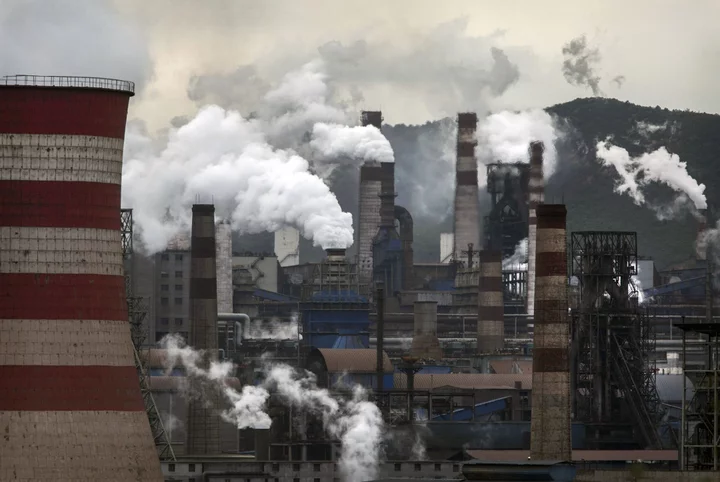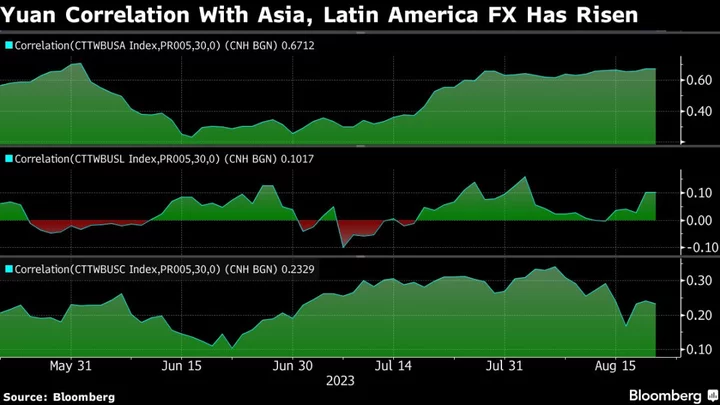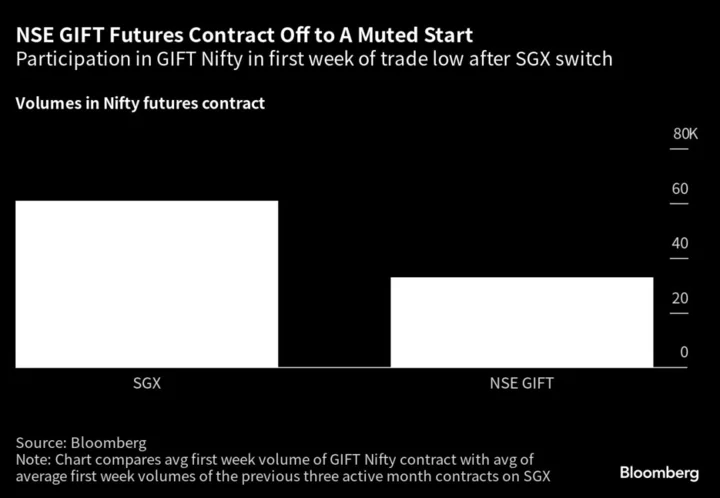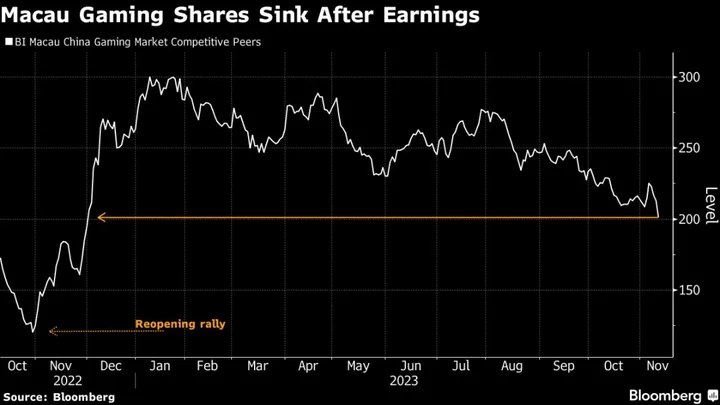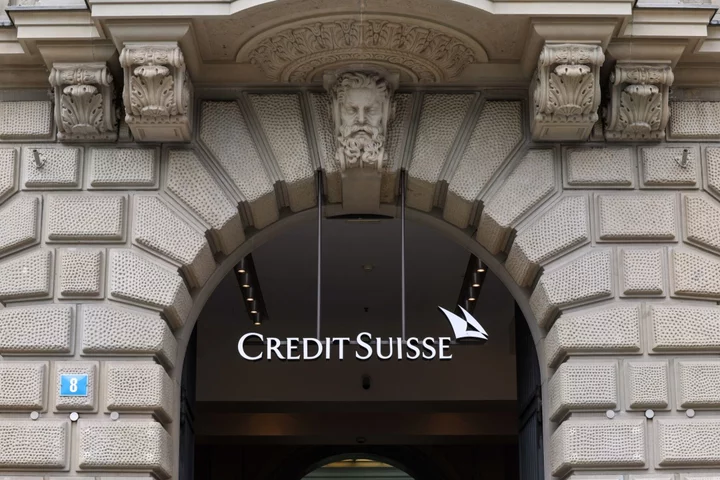On Dubai’s manmade island of Palm Jumeirah, soaring laser beams signal the latest outsized construction project getting started. At 71 stories high and with 76 penthouses, Como Residences will be the archipelago’s highest structure — with the cheapest unit priced at 21 million dirhams ($5.7 million).
A short drive down the city’s main highway, Emirati tycoon Khalaf Ahmad Al Habtoor is starting work on a housing complex that’ll add more than 1,700 homes in a single development. It’s a trend on show just about everywhere in the emirate — builders revving their engines in what’s expected to be the strongest construction cycle since 2017.
Long known for sharp booms and busts, Dubai had one of its most dramatic downturns in 2008, when a debt fueled real estate crash left some of its biggest developers teetering on the brink of bankruptcy. The Arab Spring sweeping the Middle East revived the market in 2011 as capital from Arab nations sought safety in Dubai. But the tides quickly turned in 2014 as a collapse in oil prices sent the residential property market on a seven-year downturn.
This time round developers are hedging their bets more, demanding upfront payments covering most of the property even before construction begins. The cash coming in from wealthy investors around the world is giving the emirate’s real estate market a big cushion and reducing the need for debt — but it also leaves buyers holding more of the risk.
“Developers are capitalizing on growing demand with a sharp rise in project launch volumes,” said Prathyusha Gurrapu, head of research and advisory at the property firm Core. “With money collected from buyers in pre-sales, developers are usually able to fund much of the construction, which makes the financial risk lower than in previous years.”
Gurrapu expects residential prices to rise a further 10% to 12% this year.
Capacity Concerns
Still, there are other risks, Gurrapu said, like potential problems in the construction supply chain that could delay the completion of projects even after buyers have paid. Another is concern over the capacity of contractors to carry out work as they take on more projects at a time when many have scaled down capacity after years of a down market.
Globally, higher interest rates and economic slowdowns are expected to hit construction in many parts of the world, with some markets like the UK and China suffering particularly badly. Yet, a flood of expat arrivals and an influx of Russians looking to protect their wealth after the invasion of Ukraine have caused Dubai’s real estate prices to soar 15% over the past year and fueled this latest building boom.
So far this year, 24,658 homes have been launched in Dubai, about 37% higher than those launched during the same period in 2022, according to Core. About 28,900 off-plan residential transactions have been registered since the start of 2023, the largest number for the same period since 2009.
Off-plan properties are a popular option for foreign investors who don’t have bank accounts in the United Arab Emirates, which Dubai is part of. They tend to transfer cash directly to the developer’s escrow accounts or use crypto to pay for purchases.
Analysts and developers acknowledge the risks. Mohamed Alabbar, founder of Emaar Properties PJSC, which built the world’s tallest skyscraper, says lessons from the past shouldn’t be forgotten in the current boom.
“The big risk is that property business goes through cycles, ups and downs,” he said. “You have to maintain little debt and have reasonable cash so even if the market slows, the balance sheet and the cash position should enable us to finish our projects.”
Little Supply
Cautionary tales of what can go wrong in Dubai abound. Before the global financial crisis, buyers often paid 10% of the value of a property even before a single brick was laid and sold the contracts many times over inflating values by multiples. The rampant flipping came to a sudden halt in 2009 when government-owned developer Nakheel PJSC almost defaulted on repaying about $4 billion in bond payments. The company, along with then-parent Dubai World, was given a $10 billion lifeline by Abu Dhabi.
A painful period ensued as developers restructured billions of dollars of debt with global banks and worked through a mountain of legal disputes with angry buyers whose properties stopped mid-construction and their money was tied up for years.
A short distance from the newly-launched Como Residences, The Dubai Pearl, a four-tower project that’s been on hold for nearly 15 years, is finally being demolished and buyers are unlikely to recoup much of their investments. Palm Jebel Ali, the largest of the city’s famous palm-shaped artificial islands, is being revived after 14 years but not before many of the original buyers were left with massive losses.
Still, Dubai curtailed new developments and limited supply during the seven year period when prices declined after a previous property glut. That could limit the severity of any downturn this time, developers and analysts say.
“Will we overreach? You need a crystal ball to answer that question,” said Richard Waind, managing director at real estate agency Betterhomes. “Undoubtedly we need new homes at the moment across a broad basis.”
More Risk
These days, buyers are more willing to take the risk of making bigger down payments because the government introduced a slew of reforms.
Property firms must pay the full cost of the land before they’re permitted to sell ahead of construction. Money collected from buyers must be deposited in government escrow accounts with funds disbursed for essential construction costs. That means developers can’t easily abscond with buyer’s money, as some did during the financial crisis.
Among those putting their money into the local property market are locals and expats exhausted by soaring rents. Some investors from overseas are looking for second homes in a country where visas are easy to get.
But Dubai also doesn’t make details on purchases public, attracting property purchasers who want to fly under the radar, some researchers have said. Many of these find off plan purchases particularly attractive.
Denis Scvortov, a property broker at Ax Capital, who specializes in sales of off-plan properties said 95% of his clients live abroad, with many coming from Russia, Ukraine and former Soviet Union countries. Many use them as second homes. Brokers like Scvortov say many of their customers are wealthy enough to pay in cash, avoiding mortgages and bypassing banks.
In the past three months, the market has cooled a bit from last year’s frantic activity even though almost all new launches are being sold, he said.
Genuine Investors
Developers, meanwhile, are marching full steam ahead.
Rizwan Sajan, an Indian-born businessman who sat out Dubai’s first property boom in 2007, hopped on the bandwagon in 2015 and in the past year has been pushing ahead with six developments that’ll bring nearly 2,100 homes to the market.
“In 2008, it was a flippers’ market without any controls” said Sajan, who heads a family-owned conglomerate called Danube Group based in Dubai. “But today, it’s genuine investors who are buying here because of the situation in the world and because they’re looking to either create rental income or keep the properties as second homes.”
Buyers in Como Residences, the tower on Palm Jumeirah, must pay 80% of the value before the property is completed in mid 2027, according to a company advertisement.
Emaar has the lion’s share of new home construction. It was followed by privately-owned Damac Properties and Azizi Developments last year. During the first quarter, Emaar’s sales grew 25.8% from a year earlier.
This month Emaar announced the launch of a $20 billion luxury waterfront project that will have over 7,000 residential units with mainly large mansions and villas.
Still, Alabbar said he keeps a hawkish gaze on customer payments. “Everything is sold out now and collection is incredibly strong,” he said. “But are those people going to be paying their installments on time six months from now or a year out? That’s so critical and we all have to be careful.”


